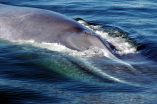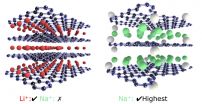(Press-News.org) ITHACA, N.Y. - To encode data, today's computer memory technology uses electric currents - a major limiting factor for reliability and shrinkability, and the source of significant power consumption. If data could instead be encoded without current - for example, by an electric field applied across an insulator - it would require much less energy, and make things like low-power, instant-on computing a ubiquitous reality.
A team at Cornell University led by postdoctoral associate John Heron, who works jointly with Darrell Schlom, professor of Industrial Chemistry in the Department of Materials Science and Engineering, and Dan Ralph, professor of Physics in the College of Arts and Sciences, has made a breakthrough in that direction with a room-temperature magnetoelectric memory device. Equivalent to one computer bit, it exhibits the holy grail of next-generation nonvolatile memory: magnetic switchability, in two steps, with nothing but an electric field. Their results were published online Dec. 17 in Nature.
Study: http://www.nature.com/nature/journal/v516/n7531/full/nature14004.html
"The advantage here is low energy consumption," Heron said. "It requires a low voltage, without current, to switch it. Devices that use currents consume more energy and dissipate a significant amount of that energy in the form of heat. That is what's heating up your computer and draining your batteries."
The researchers made their device out of a compound called bismuth ferrite, a favorite among materials mavens for a spectacularly rare trait: It's both magnetic - like a fridge magnet, it has its own, permanent local magnetic field - and also ferroelectric, meaning it's always electrically polarized, and that polarization can be switched by applying an electric field. Such so-called ferroic materials are typically one or the other, rarely both, as the mechanisms that drive the two phenomena usually fight each other.
This combination makes it a "multiferroic" material, a class of compounds that has enjoyed a buzz over the last decade or so. Paper co-author Ramamoorthy Ramesh, Heron's Ph.D. adviser at University of California, Berkeley, first showed in 2003 that bismuth ferrite can be grown as extremely thin films and can exhibit enhanced properties compared to bulk counterparts, igniting its relevance for next-generation electronics.
Because it's multiferroic, bismuth ferrite can be used for nonvolatile memory devices with relatively simple geometries. The best part is it works at room temperature; other scientists, including Schlom's group, have demonstrated similar results with competing materials, but at unimaginably cold temperatures, like 4 Kelvin (-452 Fahrenheit) - not exactly primed for industry. "The physics has been exciting, but the practicality has been absent," Schlom said.
A key breakthrough by this team was theorizing, and experimentally realizing, the kinetics of the switching in the bismuth ferrite device. They found that the switching happens in two distinct steps. One-step switching wouldn't have worked, and for that reason theorists had previously thought what they have achieved was impossible, Schlom said. But since the switching occurs in two steps, bismuth ferrite is technologically relevant.
The multiferroic device also seems to require an order of magnitude lower energy than its chief competitor, a phenomenon called spin transfer torque, which Ralph also studies, and that harnesses different physics for magnetic switching. Spin transfer torque is already used commercially but in only limited applications.
They have some work to do; for one thing they made just a single device, and computer memory involves billions of arrays of such devices. They need to ramp up its durability, too. But for now, proving the concept is a major leap in the right direction.
"Ever since multiferroics came back to life around 2000, achieving electrical control of magnetism at room temperature has been the goal," Schlom said.
INFORMATION:
The paper, "Deterministic Switching of Ferromagnetism at Room Temperature Using an Electric Field," includes collaborators from University of Connecticut; University of California, Berkeley; Tsinghua University; and Swiss Federal Institute of Technology in Zurich. The research was supported by the National Science Foundation and the Kavli Institute at Cornell for Nanoscale Science, of which Ralph and Schlom are both members.
Scientists from WCS (Wildlife Conservation Society), the Universidad Austral de Chile, the Blue Whale Center, the American Museum of Natural History (AMNH), NOAA, and other organizations are examining molecular clues to answer a big question: how many types of blue whales exist in the waters of the southeastern Pacific?
The answer seems to be two distinct populations, according to a genetic study comparing the blue whales off the southern coast of Chile with those swimming in the waters of Antarctica and other nearby regions. One of the populations could be made up of ...
By 2050, a majority of U.S. coastal areas are likely to be threatened by 30 or more days of flooding each year due to dramatically accelerating impacts from sea level rise, according to a new NOAA study, published today in the American Geophysical Union's online peer-reviewed journal Earth's Future.
The findings appear in the paper From the Extreme to the Mean: Acceleration and Tipping Points for Coastal Inundation due to Sea Level Rise, and follows the earlier study, Sea Level Rise and Nuisance Flood Frequency Changes around the United States, by the report's co-author, ...
MANHATTAN, KANSAS -- A Kansas State University engineering team has discovered some of graphene oxide's important properties that can improve sodium- and lithium-ion flexible batteries.
Gurpreet Singh, assistant professor of mechanical and nuclear engineering, and Lamuel David, doctoral student in mechanical engineering, India, published their findings in the Journal of Physical Chemistry in the article "Reduced graphene oxide paper electrode: Opposing effect of thermal annealing on Li and Na cyclability."
Graphene oxide is an insulating and defective version of graphene ...
Many genetic mutations in visual pigments, spread over millions of years, were required for humans to evolve from a primitive mammal with a dim, shadowy view of the world into a greater ape able to see all the colors in a rainbow.
Now, after more than two decades of painstaking research, scientists have finished a detailed and complete picture of the evolution of human color vision. PLOS Genetics is publishing the final pieces of this picture: The process for how humans switched from ultraviolet (UV) vision to violet vision, or the ability to see blue light.
"We ...
Ibuprofen, a common over-the-counter drug used to relieve pain and fever, could hold the keys to a longer healthier life, according to a study by researchers at the Buck Institute for Research on Aging. Publishing in PLoS Genetics on December 18th, scientists showed that regular doses of ibuprofen extended the lifespan of yeast, worms and fruit flies.
"There is a lot to be excited about," said Brian Kennedy, PhD, CEO of the Buck Institute, who said treatments, given at doses comparable to those used in humans, extended lifespan an average of 15 percent in the model ...
Many animals may have a previously under-appreciated ability to make up for lost time with more effort, according to new research publishing this week in PLOS Computational Biology.
This capability could help scientists better understand how animals make efficient decisions in changing environments -- and ultimately help ensure the survival of a species.
Researchers from Princeton University challenge the conventional view that animals face a simple trade-off between the speed and the accuracy of their decisions. Adrian de Froment, Daniel Rubenstein and Simon Levin ...
Most vaccines work by inducing an immune response characterized by neutralizing antibodies against the respective pathogen. An effective HIV vaccine has remained elusive so far, but researchers have continued to make progress, often employing innovative methods. A study published on December 18th in PLOS Pathogens reports that a combination of antibodies from llamas can neutralize (destroy) a wide range of circulating HIV viruses.
After initial disappointment that HIV vaccine candidates were unable to elicit neutralizing antibodies, researchers found that some HIV-infected ...
COLLEGE STATION -- A common over-the-counter drug that tackles pain and fever may also hold keys to a longer, healthier life, according to a Texas A&M AgriLife Research scientist.
Regular doses of ibuprofen extended the lifespan of multiple species, according to research published in the journal Public Library of Science-Genetics.
"We first used baker's yeast, which is an established aging model, and noticed that the yeast treated with ibuprofen lived longer," said Dr. Michael Polymenis, an AgriLife Research biochemist in College Station. "Then we tried the same process ...
This news release is available in Japanese, French, Spanish and Chinese on EurekAlert! Chinese. The Rosetta spacecraft caught up with the comet known as 67P/Churyumov-Gerasimenko beyond Mars this August, and its preliminary results--along with the studies it will allow in the near-future--top this year's list of the most important scientific breakthroughs, according to the editors of Science.
This annual list of groundbreaking scientific achievements, selected by Science and its international nonprofit publisher, AAAS, also includes groundbreaking advances in medicine, ...
Research led by the Teichmann group on the Wellcome Genome Campus has identified a fundamental mechanism for controlling protein function. Published in the journal Science, the discovery has wide-ranging implications for biotechnology and medicine.
The shape of a protein determines its function, for example whether it is able to interact with another protein or with a drug. But a protein's shape is not constant - it may change in response to different conditions, or simply as a matter of course.
Understanding how this process works is key to figuring out how to manipulate ...





